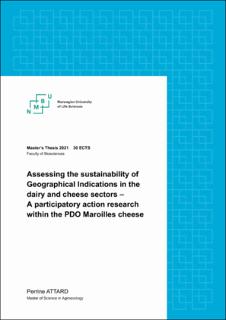| dc.contributor.advisor | Breland, Tor Arvid | |
| dc.contributor.advisor | Gautier, Cathy | |
| dc.contributor.advisor | Annes, Alexis | |
| dc.contributor.advisor | Ferrer, Aurélie | |
| dc.contributor.advisor | Lieblein, Geir | |
| dc.contributor.advisor | Wezel, Alexander | |
| dc.contributor.author | Attard, Perrine | |
| dc.coverage.spatial | France | en_US |
| dc.date.accessioned | 2023-02-28T12:18:45Z | |
| dc.date.available | 2023-02-28T12:18:45Z | |
| dc.date.issued | 2021 | |
| dc.identifier.uri | https://hdl.handle.net/11250/3054661 | |
| dc.description | Appendices 15 and 16 has been removed from the original thesis for confidentiality reasons.
Les annexes 15 et 16 ont été supprimées de la thèse originale pour des raisons de confidentialité. | en_US |
| dc.description.abstract | The actual contribution of Geographical Indications (GIs) to sustainable development (SD) is a topic that is gaining increasing attention in the context of growing societal and political pressures. While empirical knowledge is still subject, there is evidence that GIs should assess their sustainability performances to communicate the inherent sustainable attributes of their products to consumers. However, measuring the sustainability of any system is a “wicked” issue and would require soft-system approaches, which are often missing in the current literature.
These limitations pointed out, the present work aimed to consolidate the Qualimentaire Sustainability Assessment Tool (QSAT) in order to design a tool that is easy to use, robust, holistic, inclusive and action-oriented, and applicable to all dairy and cheese GI in France and beyond. To this end, Participatory Action Research was conducted with the Maroilles PDO. It resulted in an innovative evaluation framework, composed of 241 indicators based on the five dimensions of Economy, Environment, Social, but also Governance and Territory, and taking into account all GI stakeholders.
The discussion underlines the importance of a bottom-up participatory approach as an essential prerequisite for the applicability of the results on the field and the appropriation of the tool by local actors. Results of this study showed that the QSAT functions as a catalyst for exchanges among GI actors and collective learning about SD and thus goes far beyond a simple evaluation grid. However, a number of trade-offs were observed regarding the initial research objectives, which called for the need to not only develop an evaluation grid but a whole methodology drew on the stepwise and participatory process presented here. | en_US |
| dc.description.abstract | La contribution réelle des Indication Géographiques (IG) au développement durable (DD) est un sujet remporte une attention grandissante dans un contexte de pressions sociétales et politiques croissantes. Si les connaissances empiriques sont encore pauvres sur le sujet, il apparaît évident que les IG doivent désormais être en mesure d’évaluer leurs performances en matière de durabilité afin de communiquer aux consommateurs la valeur-ajoutée de leurs produits. Cependant, mesurer la durabilité de tout système est un processus complexe et nécessiterait une approche Soft-System, approche faisant souvent défaut dans la littérature actuelle.
Ces limites mises en évidence, le présent travail a visé à consolider l'outil d'évaluation de la durabilité (QSAT) conçu par l’organisme Qualimenaire afin de concevoir une grille d’évaluation à la fois simple d’utilisation, robuste, holistique, inclusive, orientée vers l'action et applicable à l’ensemble des filières AOP laitières et fromagères de France et au-delà. Pour ce faire, une recherche-action participative a été menée avec l’AOP Maroilles. Il en est résulté un cadre d’évaluation innovant, composé de 241 indicateurs articulés autour des cinq dimensions de la durabilité: l’économie, l’environnement, le social mais aussi la gouvernance et le territoire et prenant en compte l’ensemble des acteurs de l’IG.
La discussion souligne l'importance des approches participatives bottom-up comme prérequis essentiel à l’applicabilité des résultats sur le terrain et de son appropriation par les acteurs locaux. L’outil QSAT fonctionne ainsi comme un catalyseur d’échanges et d’apprentissage collectif sur la notion de DD, et va donc bien au-delà d’une simple grille d’évaluation. Cependant, un certain nombre de compromis ont été observés par rapport aux objectifs de recherche initiaux, ce qui a nécessité de développer non seulement une grille d'évaluation mais toute une méthodologie s'inspirant du processus progressif et participatif présenté ici. | en_US |
| dc.description.sponsorship | The Region Hauts-de-France | en_US |
| dc.language.iso | eng | en_US |
| dc.publisher | Norwegian University of Life Sciences, Ås | en_US |
| dc.rights | Attribution-NonCommercial-NoDerivatives 4.0 Internasjonal | * |
| dc.rights.uri | http://creativecommons.org/licenses/by-nc-nd/4.0/deed.no | * |
| dc.subject | Geographical Indications | en_US |
| dc.subject | Sustainable Development | en_US |
| dc.subject | Dairy products | en_US |
| dc.subject | Cheesemaking | en_US |
| dc.title | Assessing the sustainability of Geographical Indications in the dairy and cheese sectors : a participatory action research within the PDO Maroilles cheese | en_US |
| dc.type | Master thesis | en_US |
| dc.description.localcode | M-AE | en_US |

